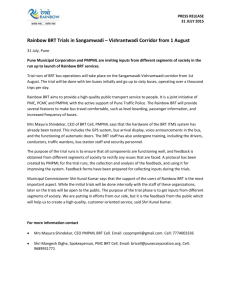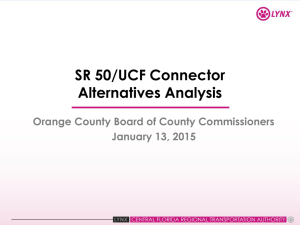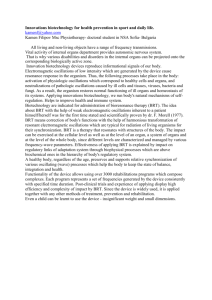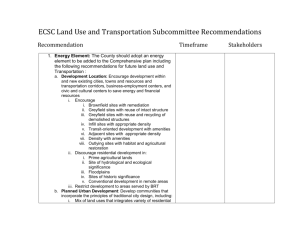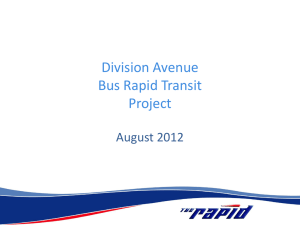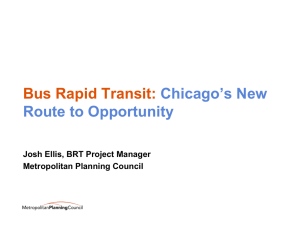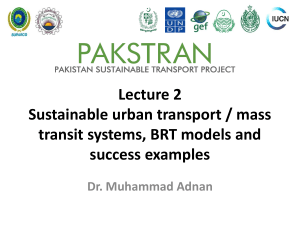BuS Rapid TRanSiT: a Canadian peRSpeCTive
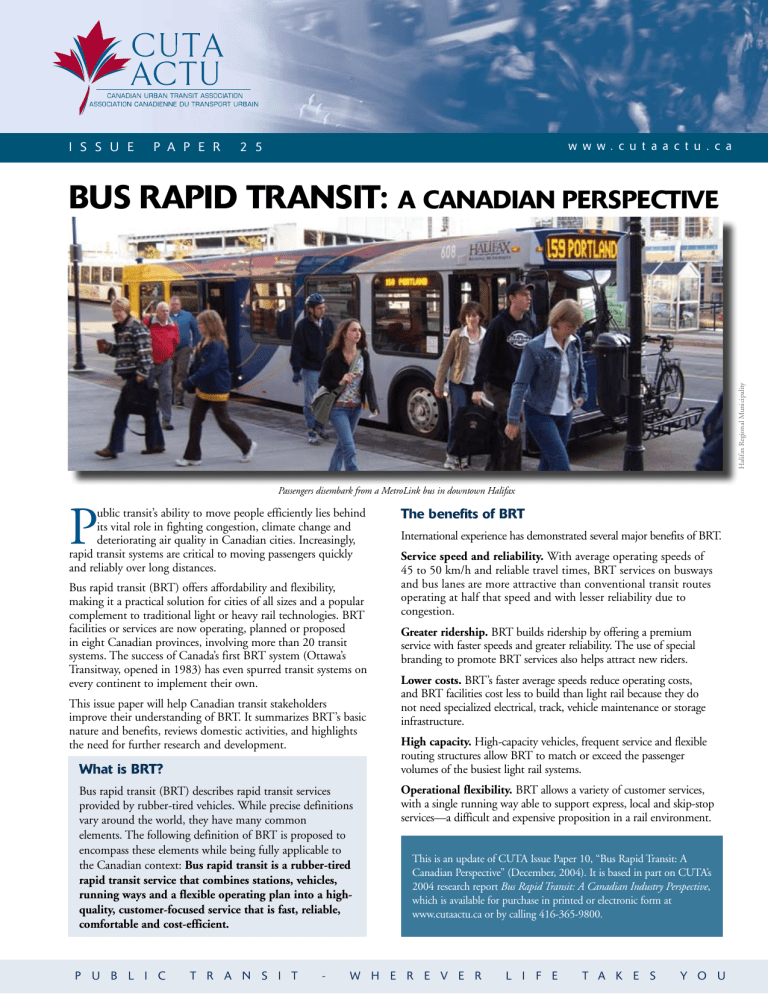
i S S u e P a P e R 2 5 w w w . c u t a a c t u . c a
BuS Rapid TRanSiT: a Canadian peRSpeCTive
Passengers disembark from a MetroLink bus in downtown Halifax
P ublic transit’s ability to move people efficiently lies behind its vital role in fighting congestion, climate change and deteriorating air quality in Canadian cities. Increasingly, rapid transit systems are critical to moving passengers quickly and reliably over long distances.
Bus rapid transit (BRT) offers affordability and flexibility, making it a practical solution for cities of all sizes and a popular complement to traditional light or heavy rail technologies. BRT facilities or services are now operating, planned or proposed in eight Canadian provinces, involving more than 20 transit systems. The success of Canada’s first BRT system (Ottawa’s
Transitway, opened in 1983) has even spurred transit systems on every continent to implement their own.
The benefits of BRT
International experience has demonstrated several major benefits of BRT.
Service speed and reliability.
With average operating speeds of
45 to 50 km/h and reliable travel times, BRT services on busways and bus lanes are more attractive than conventional transit routes operating at half that speed and with lesser reliability due to congestion.
Greater ridership.
BRT builds ridership by offering a premium service with faster speeds and greater reliability. The use of special branding to promote BRT services also helps attract new riders.
This issue paper will help Canadian transit stakeholders improve their understanding of BRT. It summarizes BRT’s basic nature and benefits, reviews domestic activities, and highlights the need for further research and development.
Lower costs.
BRT’s faster average speeds reduce operating costs, and BRT facilities cost less to build than light rail because they do not need specialized electrical, track, vehicle maintenance or storage infrastructure.
High capacity.
High-capacity vehicles, frequent service and flexible routing structures allow BRT to match or exceed the passenger volumes of the busiest light rail systems.
What is BRT?
Operational flexibility. BRT allows a variety of customer services, with a single running way able to support express, local and skip-stop services—a difficult and expensive proposition in a rail environment.
Bus rapid transit (BRT) describes rapid transit services provided by rubber-tired vehicles. While precise definitions vary around the world, they have many common elements. The following definition of BRT is proposed to encompass these elements while being fully applicable to the Canadian context: Bus rapid transit is a rubber-tired rapid transit service that combines stations, vehicles, running ways and a flexible operating plan into a highquality, customer-focused service that is fast, reliable, comfortable and cost-efficient.
This is an update of CUTA Issue Paper 10, “Bus Rapid Transit: A
Canadian Perspective” (December, 2004). It is based in part on CUTA’s
2004 research report Bus Rapid Transit: A Canadian Industry Perspective , which is available for purchase in printed or electronic form at www.cutaactu.ca or by calling 416-365-9800.
P u b l i C T R a N S i T - w h e R e v e R l i F e T a k e S Y O u
York Region’s VIVA service integrates a number of advanced technologies
Incremental implementation.
BRT systems can be implemented in stages, with buses using a BRT facility to traverse a congested corridor before switching to a relatively uncongested roadway.
Land use change.
BRT can stimulate the development or redevelopment of compact, pedestrian- and transit-friendly land uses, when supported by complementary land use and zoning policies.
BRT in Canada
While Canadian transit agencies have a common understanding of
BRT, implementation has varied with local context and fiscal realities.
Dedicated busways are existing or planned in only a few communities including Ottawa, Gatineau, Mississauga and York Region. Most BRT systems operate on arterial roads with transit priority measures to give buses preference over mixed traffic in congestion. Some transit agencies are rolling out BRT service in stages, and planning enhancements to serve future growth in demand.
Canada’s more advanced BRT systems tend to be found in larger urban areas with severe traffic congestion in key corridors. Even smaller cities, though, are starting to address localized congestion by adding
BRT features to existing trunk services.
B R T a c T i v i T y i n c a n a d a
Existing services
Calgary, Alberta. Limited-stop service (42 stops over
47 km) in two corridors linking downtown to suburban communities via Route 301–BRT North/West, operating every 10 minutes in peak periods and 20 minutes at mid-day on weekdays, and 30 minutes at other times, seven days a week.
Halifax, Nova Scotia. Three MetroLink routes in two major corridors linking suburban areas to downtown
Halifax with two terminals, 565 free Park & Ride spaces, several on-street stations, 20 state-of-the-art buses, transit priority signalization and queue jump lanes.
Kelowna, British Columbia. Linking the Queensway
Transit Exchange to the UBC-Okanagan Campus via Route
97 Express, with 15-minute service in peak periods and
30-minute service at other times. Expansion planned to serve the Westbank Town Centre.
Montreal-Longueuil, Quebec. Median busway on
Highway 10 with 3 km of bus-only facility joining two Park
& Ride lots to the Champlain Bridge, which also has 6 km of reversible bus-only contraflow lanes.
Ottawa, Ontario. Extensive Transitway system with 30 km of bus-only roadway complemented by reserved freeway and arterial bus lanes, carrying up to 10,000 passengers and
185 buses per hour in each direction.
Quebec City, Quebec. Two high-frequency Métrobus corridors linking major activity centres over more than
30 km, involving reserved lanes with limited stops, transit priority signals, stations integrated into buildings, and a distinctive image. Exclusive use of articulated buses is pending, and three new corridors will be developed.
Saint John, New Brunswick. Weekday peak period Comex service between Uptown Saint John and four suburban communities—Grand Bay-Westfield, Hampton, Rothesay and Quispamis.
Saskatoon, Saskatchewan. Four DART routes in two corridors providing high-speed, high-frequency service using dedicated buses with distinctive livery.
Waterloo, Ontario. iXpress service connecting 13 stations using distinctive buses that operate on arterial roads. Offers transit signal priority at 17 intersections, visual and audio
“next station” announcements on buses, automatic vehicle location system, automatic passenger counters, and planned real-time arrival displays.
York Region, Ontario. Five VIVA routes in four designated corridors with distinctive buses, queue jump lanes, traffic signal priority measures, automatic vehicle location system, off-board fare payment and variable message signs at stops/ terminals offering “next bus” information.
Quebec City’s Métrobus service relies on reserved bus lanes i s s u e P a p e r 2 5 w w w . c u t a a c t u . c a
B R T a c T i v i T y i n c a n a d a
Planned services
Brampton, Ontario. AcceleRide network on four arterial corridors over two phases, and full integration with neighbouring systems (Mississauga, York Region) and GO Transit; initially in mixed traffic with queue-jump lanes and signal priority at major intersections, plus on-street real-time bus arrival information.
Gatineau, Quebec. 18-km Rapibus system on exclusive bus lanes in a shared right-of way with a bike path and railway track, also featuring reserved lanes and a one-lane shared-use bus/rail bridge with alternating flow across the Gatineau River.
Greater Toronto, Ontario. 100-km GO Transit regional BRT network connecting Oakville, Mississauga, York and Pickering with 45 stations and 5,000 park-and-ride spaces.
Hamilton, Ontario. Two major lines including an east-west line from Eastgate Mall to McMaster University, and a north-south line from Hamilton Intrnl. Airport in the south through downtown to the waterfront in the north.
London, Ontario. Service in key corridors offering connections among the four shopping centre sub-terminals, two postsecondary institutions, two additional transit nodes and the downtown area.
Mississauga, Ontario. Service on a grade-separated, two-lane bus-only road parallel to Highway 403 and Eglinton Avenue, with stations connecting to local transit, park-and-ride and kiss-andride facilities (part of the GO Transit BRT system, noted above).
Toronto, Ontario. Facilities on Yonge Street (Finch to Steeles) to complement adjacent BRT facilities of York Region (see previous page), and a facility between Downsview Station and York
University/Steeles Avenue.
Vancouver, British Columbia. Enhanced high-frequency Rapid
Bus services in Broadway, Hastings and 41st Avenue corridors, combining dedicated bus lanes and mixed operations supported by transit signal priority, readily identifiable stations, and amenities including real-time stop information. Several other BRT corridors in conceptual stages including arterial median busways in Surrey and Langley, and a busway integrated into Highway 1 expansion project.
Victoria, British Columbia. 19-km Victoria-Langford line through downtown and along the Douglas Street/Highway 1 corridor, with first phase (2.8 km on Douglas St) funded, detailed planning and design underway, and groundbreaking scheduled for spring 2008.
Winnipeg, Manitoba. Two major corridors with bus-only running ways from downtown to the city’s southwestern and eastern areas, with a downtown section on the Graham Transit
Mall already in operation.
Conceptual services
Durham Region, Ontario. BRT service in dedicated lanes along
Main Street Highway 2 connecting the Oshawa Growth Centre and the Pickering Growth Centre, plus high-frequency Taunton Road/
Rossland Road service using transit priority measures and intelligent transportation systems.
Edmonton, Alberta. Corridors linking the west, north and southeast areas with the downtown area and post-secondary institutions.
Montreal, Quebec. Services in high-demand corridors including
Henri-Bourassa Boulevard and Pie IX-downtown, as well as opportunities to operate along unused railway corridors.
i s s u e P a p e r 2 5
Downtown Winnipeg’s Graham Transit Mall is the initial element of a larger BRT system
BRT elements, products and technologies
BRT has several important features, many of which are extensions of more conventional transit concepts.
Running ways. There are three types of BRT travel lanes:
• Exclusive busways generally not used by other traffic, located either in the median or boulevard of an existing road, or in a separate corridor
• Dedicated lanes for transit or high-occupancy vehicles on existing roads, possibly with transit signal priority to maintain schedules and service intervals
• Mixed traffic lanes where dedicated facilities are not needed to guarantee reliability, and where isolated delay points are addressed through queue jumps or signal priority measures
Stops and stations.
Stations let passengers access BRT services from nearby developments, or transfer to other transit services or travel modes. Safe, comfortable and attractive stations offer weather protection, seating, route schedules and maps, lighting and ample space for waiting and boarding. Other amenities could include heating, real-time passenger information, fare vending points, and convenience stores or bank machines. BRT stations often have a unique visual identity, and benefit from proximity to existing or potential transit-oriented developments.
Vehicles.
While the use of conventional buses in BRT service is common, a new breed of BRT vehicle exists. A growing number of manufacturers now offer vehicles with higher passenger capacities, distinctive styling and an emphasis on passenger comfort.
Operating plan. BRT facilities can support several types of service at the same time, including all-stops service, peak or counter-peak direction express or limited stop service, and local arterial or feeder service.
Fare collection. The speed and reliability of BRT systems can be hampered by conventional fare collection. Helpful strategies include smart cards, prepaid passes and tickets, multi-door boarding, fare-free zones, or “proof of payment” policies in vehicles and platform areas.
Intelligent transportation systems (ITS).
Computer and communications technologies can make BRT more convenient, safe and reliable. Supportive elements include automated vehicle location to improve service control and enable real-time passenger information, transit signal priority measures to reduce delays in mixed traffic, automated next stop announcements, and video monitoring for enhanced security.
w w w . c u t a a c t u . c a
Lincoln Fields Station is a major hub on Ottawa’s Transitway system
Guidance systems. By eliminating driver variation and steering error, guided vehicles with precision docking enable faster and safer boarding for passengers, particularly those with strollers or wheelchairs. Guidance systems also enable lane tracking that can increase passenger comfort while reducing right-of-way needs and crash frequency. Mechanical guidance systems have been used for many years internationally, and optical and grid systems are now being developed and tested.
Supportive measures
Several supportive actions can help communities maximize the value of their investment in BRT facilities and services.
Land use relationships.
BRT success is ultimately dependent on how services and infrastructure relate to adjacent land uses. Higher densities increase the number of clients within walking distance. Mixed-use developments decrease auto dependence and create vibrant, pedestrianfriendly environments.
Planning and modal integration.
BRT systems should be fully integrated with walking, cycling, driving, taxis and other transit options through station design and transportation demand management (TDM) programs.
Marketing and information. BRT implementation calls for marketing to four key stakeholder groups: decision-makers, taxpayers, customers and employees. A comprehensive communications and marketing plan should use a variety of tools including newsletters, community meetings, advertising, branding and special events.
Design considerations. BRT is more than a series of bus stops connected by a road, and requires a coherent and often customized design. Grades and alignments must provide safety, comfort and speed. Stations must be integrated into the community with features like park and ride lots, bus lay-up areas, security measures, lighting and advanced passenger information that may represent new endeavours for some transit systems.
Design parameters like vertical clearances, running way and intersection geometries, pavements and signage may vary from road design standards and require special consideration.
For more information
Bus Rapid Transit: A Canadian Industry Perspective , McCormick Rankin Corporation for CUTA, 2004
(available at www.cutaactu.ca/en/node/1630)
BRT Planning Guide , Institute for Transportation and Development Policy (available at www.itdp.org/brt_guide)
“Bus Rapid Transit,” Federal Transit Administration (www.fta.dot.gov/brt)
Bus Rapid Transit Practitioner’s Guide , TCRP Report 118, Transportation Research Board, 2007
(available at www.trb.org)
Future needs in Canada
Research and development in several important areas could make BRT more effective and easy to implement.
BRT definition.
A Canadian definition of BRT (highlighted on page 1 of this issue paper) should be adopted and disseminated.
BRT inventory.
A national inventory of BRT facilities and services should be developed to minimize the time and effort required to conduct basic BRT research in Canada.
International awareness.
An international inventory of BRT facilities and services should be developed, with a primary focus on activities in regions similar to Canada (e.g. United States,
Europe, Australia, New Zealand). This would help transit agencies to develop BRT ideas, suppliers to develop new products and international sales opportunities, and senior governments to learn from BRT policy in other nations.
Vehicles.
A Canadian BRT vehicle handbook should be developed to identify vehicles suited to different purposes, and explain their costs and benefits. This would help transit agencies review and select vehicles best suited to their needs.
Planning guidelines.
A BRT planning guide should be developed to explain analysis techniques and tools, regulatory and legal issues, marketing and communication strategies, engineering and design con-siderations, technology and equipment, and implementation issues.
Design guidelines. BRT design guidelines for running ways, stops and stations would help agencies minimize their technical, financial and scheduling risks. Guidelines could recommend
BRT practices for many applications, and indicate where customization could better meet local needs.
Intelligent transportation systems.
A guide should be created to help agencies identify ITS strategies and components for different BRT types, their costs and benefits, and how to put them in place. Key topics include automatic vehicle location systems and transit priority technologies.
Land use.
A study of BRT’s relationship to land use should be undertaken, including international experiences and Canadian examples. This would help municipalities in their planning efforts, and educate the development community about BRT’s ability to improve land values.
Fare collection.
A study on BRT fare collection should be undertaken to describe alternatives, implementation issues and costs.
Vehicle guidance. The viability of mechanical guidance technology in the Canadian climate should be tested.
Bus Rapid Transit, Volume 1: Case Studies in Bus Rapid Transit , TCRP Report 90,
Transportation Research Board, 2003 (available at www.trb.org)
Bus Rapid Transit, Volume 2: Implementation Guidelines , TCRP Report 90, Transportation
Research Board, 2004 (available at www.trb.org)
Bus Rapid Transit: A Handbook for Partners , California Department of Transportation,
2007 (available at www.dot.ca.gov/hq/MassTrans)
“BRT Center,” Metro Magazin e (www.metro-magazine.com/t_brt_home.cfm)
National Bus Rapid Transit Institute (www.nbrti.org)
The Canadian Urban Transit Association (CUTA) is the voice of Canada’s public transit industry. For additional information including research reports, industry updates, news bulletins and more, please contact us or visit our website.
Printed in Canada on recycled paper
Suite 1401 • 55 York Street • Toronto ON • M5J 1R7 • Canada
Telephone: 416-365-9800 • Fax: 416-365-12951 • transit@cutaactu.ca • www.cutaactu.ca
November 2007

